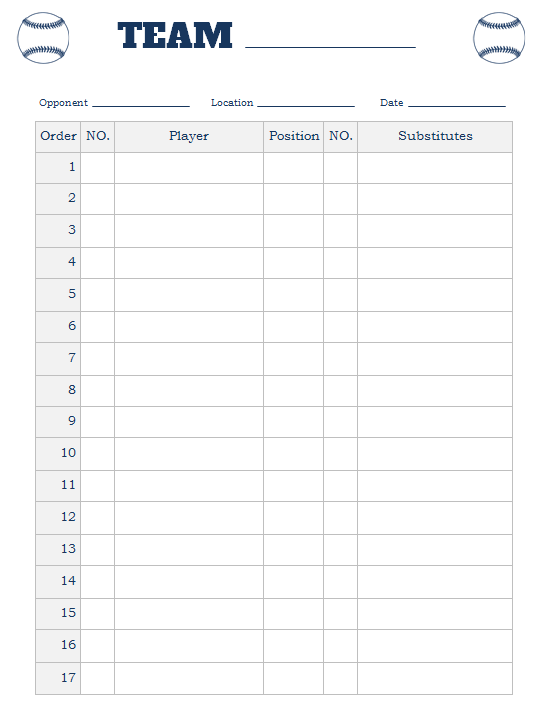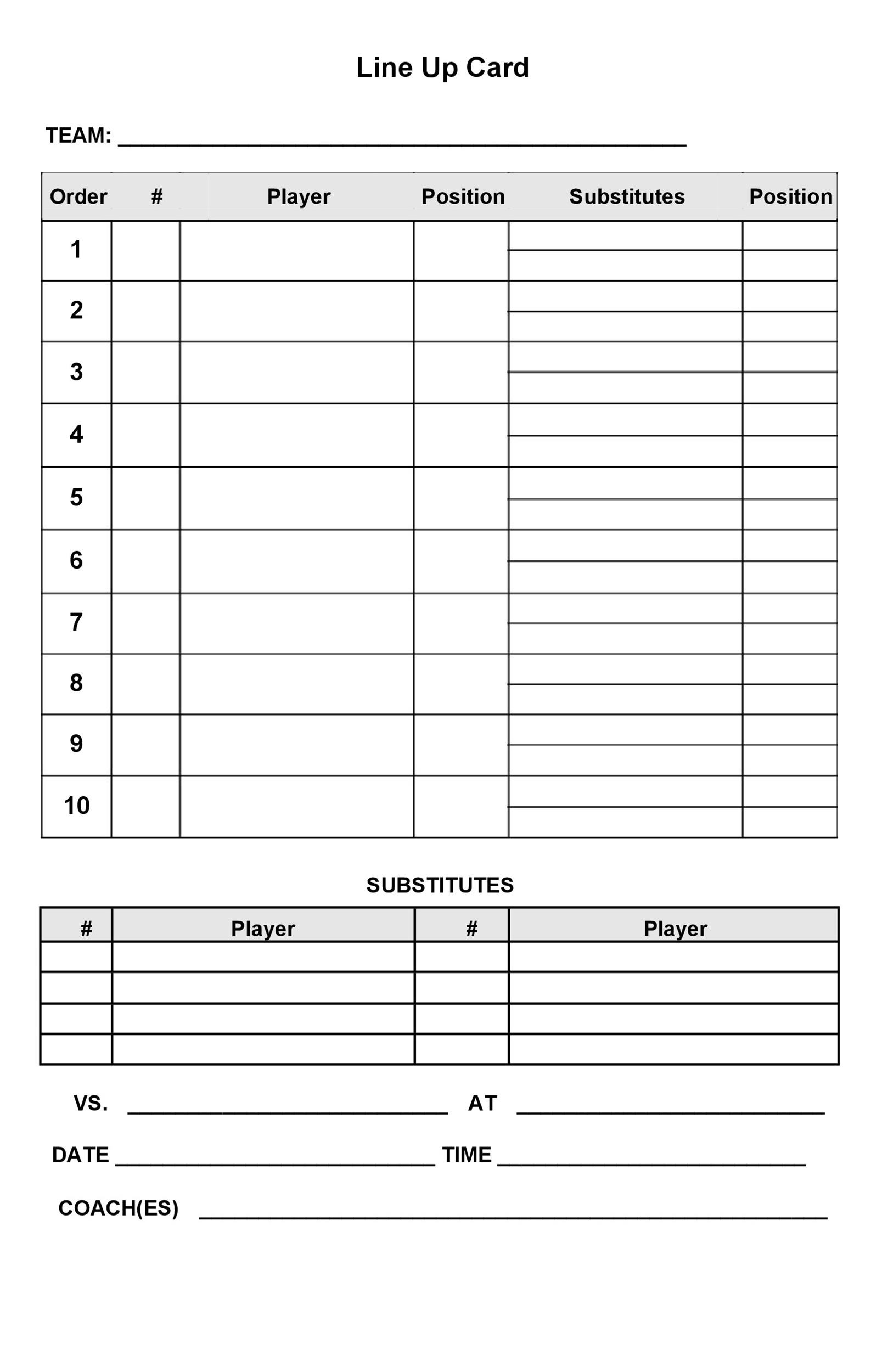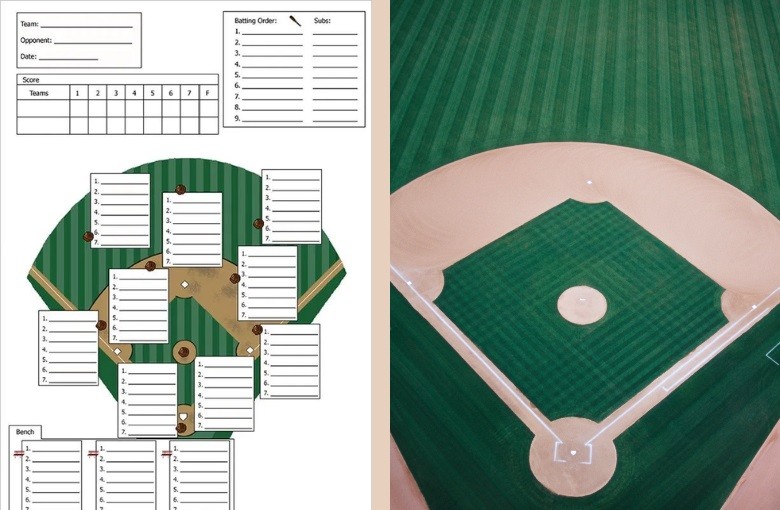Last Updated on June 11, 2025
Baseball lineup cards list the batting order and positions of players. They are essential for game strategy and record-keeping.
Coaches use lineup cards to organize player positions and batting order. These cards ensure that all team members know their roles and responsibilities during the game. Properly filling out a lineup card can affect game strategy, making it a crucial element for any baseball team.
Each card typically includes player names, numbers, and field positions. It helps coaches make quick decisions and track player performance. Lineup cards also serve as an official record for umpires and scorekeepers. Accurate lineup cards can significantly impact the game’s flow and outcome, highlighting their importance in baseball.
Importance Of Lineup Cards
Baseball lineup cards are vital tools for coaches and managers. They help in planning and managing the team effectively. Understanding their importance can give your team a competitive edge.
Strategic Planning
Lineup cards aid in strategic planning. Coaches can position players where they perform best. This ensures optimal performance from each player.
Lineup cards also help in countering the opponent’s strengths. By analyzing the opponent’s lineup, coaches can make informed decisions.
- Identify player strengths
- Optimize player positions
- Counter opponent strategies
Player Management
Effective player management is crucial in baseball. Lineup cards help coaches keep track of player rotations. This ensures that players are well-rested and ready.
Coaches can also monitor player performance using lineup cards. This helps in making necessary adjustments during the game.
| Player | Position | Performance |
|---|---|---|
| John Doe | Pitcher | Excellent |
| Jane Smith | Shortstop | Good |
- Track player rotations
- Monitor player performance
- Make necessary adjustments

Credit: www.printyourbrackets.com
Components Of A Lineup Card
A baseball lineup card is essential for organizing a team’s strategy. Coaches use it to plan the game and manage players effectively. Understanding its components helps fans appreciate the game more.
Player Positions
The lineup card lists each player’s position. These include:
- Pitcher (P)
- Catcher (C)
- First Baseman (1B)
- Second Baseman (2B)
- Third Baseman (3B)
- Shortstop (SS)
- Left Fielder (LF)
- Center Fielder (CF)
- Right Fielder (RF)
Each player has a specific role. Pitchers throw the ball to the catcher. Catchers handle pitches and guard home plate. Infielders (1B, 2B, 3B, SS) cover bases and field ground balls. Outfielders (LF, CF, RF) catch fly balls and throw to infielders.
Batting Order
The batting order is the sequence in which players bat. Coaches plan this order carefully. The goal is to maximize scoring opportunities.
- Lead-off Hitter
- Second Hitter
- Third Hitter
- Cleanup Hitter
- Fifth Hitter
- Sixth Hitter
- Seventh Hitter
- Eighth Hitter
- Ninth Hitter
The lead-off hitter has high speed and gets on base often. The cleanup hitter is usually the best hitter, aiming for home runs. The other positions balance speed, power, and on-base skills.
Having a well-organized lineup card can make a huge difference. It influences the game’s outcome and helps manage player performance.
Creating Effective Lineup Cards
Creating effective lineup cards is crucial for any baseball team. A well-organized lineup can be the difference between winning and losing. It requires careful analysis and strategic planning. Below, we’ll break down essential aspects of making effective lineup cards.
Analyzing Opponents
Analyzing opponents is the first step. You need to know their strengths and weaknesses.
Consider the following:
- Pitcher’s style: Is the pitcher left-handed or right-handed?
- Fielding skills: How strong is their defense?
- Batting lineup: Who are their key hitters?
Use this data to match your players effectively. This increases your chances of success.
Utilizing Player Strengths
Utilizing player strengths is another crucial factor. Each player has unique skills.
Here are some tips:
- Speed: Place fast players at the top of the lineup.
- Power: Middle lineup should have your best hitters.
- Consistency: Bottom lineup should have consistent hitters.
Make sure to adjust based on recent performances. Keep track of your players’ stats. This will help you make informed decisions.
| Player | Position | Strength |
|---|---|---|
| John Doe | Shortstop | Speed |
| Jane Smith | First Base | Power |
| Bob Johnson | Outfielder | Consistency |
Creating effective lineup cards is an art. It requires understanding both your team and your opponents. By analyzing opponents and utilizing player strengths, you can craft a winning lineup.

Credit: www.amazon.com
Common Mistakes To Avoid
Creating a baseball lineup card is crucial for a game. Many coaches make common mistakes that can hurt their team’s performance. By avoiding these mistakes, you can ensure your team plays its best.
Ignoring Statistics
One major mistake is ignoring player statistics. Stats show how well a player performs. Overlooking these can lead to poor choices.
Use stats to decide who bats first. A player with a high batting average should be near the top. This increases the chances of getting on base.
Also, consider a player’s on-base percentage (OBP). Players with high OBP should bat early. This helps set up scoring opportunities.
| Statistic | Importance |
|---|---|
| Batting Average | Shows hitting success |
| On-Base Percentage | Indicates frequency of getting on base |
Overlooking Versatility
Another mistake is overlooking player versatility. Players who can play multiple positions are valuable. They offer flexibility in the lineup.
Choose players who can adapt quickly. This helps if injuries occur or if you need to make strategic changes. Versatile players allow you to mix and match positions easily.
- Identify players who can play both infield and outfield.
- Consider players who are good at both offense and defense.
By focusing on versatility, you can create a more dynamic lineup. This keeps your team ready for any situation during the game.
Impact On Game Outcomes
Baseball lineup cards play a crucial role in determining game outcomes. They help managers strategize and optimize team performance. A well-constructed lineup can lead to significant advantages during the game.
Enhanced Team Performance
A carefully planned lineup card can enhance team performance. It ensures that the best players are in the right positions. This maximizes the team’s strengths and minimizes weaknesses. A good lineup balances power hitters and contact hitters. This balance can increase the chances of scoring runs.
- Optimize batting order
- Maximize player strengths
- Minimize team weaknesses
Managers use statistics to create effective lineup cards. They consider player batting averages, on-base percentages, and slugging percentages. This data-driven approach leads to better game outcomes.
| Player | Batting Average | On-Base Percentage | Slugging Percentage |
|---|---|---|---|
| John Doe | .300 | .400 | .500 |
| Jane Smith | .280 | .350 | .450 |
In-game Adjustments
Lineup cards allow managers to make in-game adjustments. They can substitute players based on the situation. For example, they might bring in a pinch hitter with a better track record against the current pitcher.
- Substitute players
- Pinch hitters
- Defensive replacements
Managers also use lineup cards for defensive strategies. They can replace weaker fielders with stronger ones. This is especially important in close games. A well-timed substitution can prevent runs and secure a win.
Lineup cards also help in pitching decisions. Managers can monitor pitcher performance and stamina. This helps them decide when to bring in relief pitchers. Proper pitcher management can significantly impact the game outcome.

Credit: templatelab.com
Frequently Asked Questions
What Is A Baseball Lineup Card?
A baseball lineup card lists the starting players and their positions.
How To Fill Out A Lineup Card?
Write player names, positions, and batting order.
Why Are Lineup Cards Important?
They help manage substitutions and track player positions.
Can Lineup Cards Be Changed During A Game?
Yes, coaches can make changes to reflect substitutions.
Where To Get Baseball Lineup Cards?
Purchase them at sports stores or online.
Conclusion
Baseball lineup cards are essential for game strategy. They help manage players and track performance efficiently. Coaches and players rely on these cards for smooth gameplay. Investing in quality lineup cards can make a significant difference. Improve your team’s performance by using well-organized and accurate lineup cards.
Keep your team prepared and ready to win.

